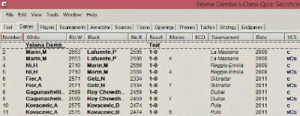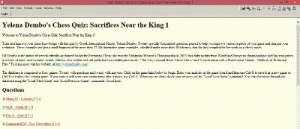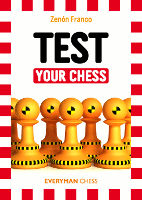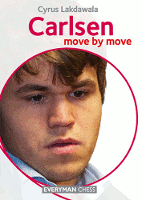Problems to Enjoy
Reviewed by Steve Goldberg
Yelena Dembo’s Chess Quiz: Sacrifices Near the King 1, 2014, by Yelena Dembo, ChessBase and PGN formats, $7.95
Yelena Dembo’s Chess Quiz: Rook Endings 1, 2014, by Yelena Dembo, ChessBase and PGN formats, $7.95
Greek International Master Yelena Dembo has put together a number of downloadable training modules that are available in ChessBase and PGN formats. In this review we will look at Sacrifices Near the King and Rook Endings. Each consists of twenty problem positions from actual games. In both products, the viewer is essentially asked how the game should proceed to victory. The ChessBase file can be used within any of the ChessBase-family of product, while the PGN file can be used with any PGN compatible software such as the Everyman Chess Viewer and many other portable device apps.
Sacrifices Near the King, as the name suggests, involves the search for a winning sacrifice in the vicinity of the enemy king. As it turns out, all twenty games have White sacrificing his way to victory.
Here is the ChessBase database view of some of the problem entries:

The pattern is that a position is presented as a game entry in the database, then the solution is given in the next database game entry. It is therefore quite easy to move from problem to solution, to the next problem and solution, etc. When accessing the problems from the Text file within the database, only the questions are provided as hyperlinks, and the user can proceed to the answer via the “load next game” command..
This is the “text” view of some of the problem entries:

The games are interesting, as sacrificial themes tend to be. There were a couple typos noted in the commentary, although the text is quite clear for the most part. There were also a couple times when my Fritz engine did not quite agree with some of the analysis provided, although not to the point of changing the final result of any of the games.
I enjoyed the positions presented in Sacrifices Near the King, although I was bothered by the lack of variety. Without giving away too much, I will just mention that all twenty positions focus on only one or two squares on the board.
I also noticed something a little odd in the first problem position of the Rook Endings offering. The position shown is as follows:
![[FEN “r5k1/pp4R1/2p1p3/7P/2PPp3/8/PP3r2/2K3R1”]](https://chesscafe.com/wp-content/uploads/2014/09/review957c.gif)
[FEN “r5k1/pp4R1/2p1p3/7P/2PPp3/8/PP3r2/2K3R1”]
The viewer is being asked a reasonable question regarding what White should be planning, but in the position given, it is Black to move, since his king is in check. Black only has two legal moves (…Kf8 and …Kh8), and …Kf8 immediately loses to Rg8+, so Black must move …Kh8.
So why isn’t the position shown after …Kh8, rather than what is actually presented? It is a half-move too soon. This oddity is often repeated among the twenty problems in Rook Endings. Not every time, but enough to be annoying.
There were a couple grammatical errors in some of the commentary, but these will not interfere with the user’s understanding of what is written. Again, there were a few instances in which Fritz did not completely agree with the analysis, but there was only one case I came across where it made a difference in the game outcome.
This was in the game Navara-Jones, in which Black appears to equalize with 55…Kxd5 instead of the game move, 55…Rb4. While a move earlier White could have played any one of three winning choices, instead of 55.Rf7. No mention is made of this in the commentary. In the actual game, White won.
Nevertheless, a number of the positions are quite interesting. I especially enjoyed the following problem, from Nakamura-Ivanchuk, Moscow 2011:
![[FEN “8/5pk1/2p3p1/1p6/7p/PpPrP2P/5PP1/2R3K1”]](https://chesscafe.com/wp-content/uploads/2014/09/review957d.gif)
[FEN “8/5pk1/2p3p1/1p6/7p/PpPrP2P/5PP1/2R3K1”]
Black advanced 38…c5, and play continued 39.Kf1 c4 40.Ke2 Rxc3, at which point Nakamura resigned. The commentary states “Black created a protected passed pawn and then won with a nice tactical shot.”
The final position is as follows:
![[FEN “8/5pk1/6p1/1p6/2p4p/Ppr1P2P/4KPP1/2R5”]](https://chesscafe.com/wp-content/uploads/2014/09/review957e.gif)
[FEN “8/5pk1/6p1/1p6/2p4p/Ppr1P2P/4KPP1/2R5”]
There were a couple problems, not as obvious as this, where a little further analysis might have been helpful, past the point where the losing side resigned. I did appreciate that the Rook Endings problems showed quite a bit of variety, in contrast to the Sacrifices problems. In final analysis, I think most players will enjoy the set of twenty problems in each volume.
My assessment of this product: ![]()
Order Rook Endings 1
by Yelena Dembo
Order Sacrifices Near the King 1
by Yelena Dembo
© 2014 ChessEdu.org. All Rights Reserved.



Leave a Reply